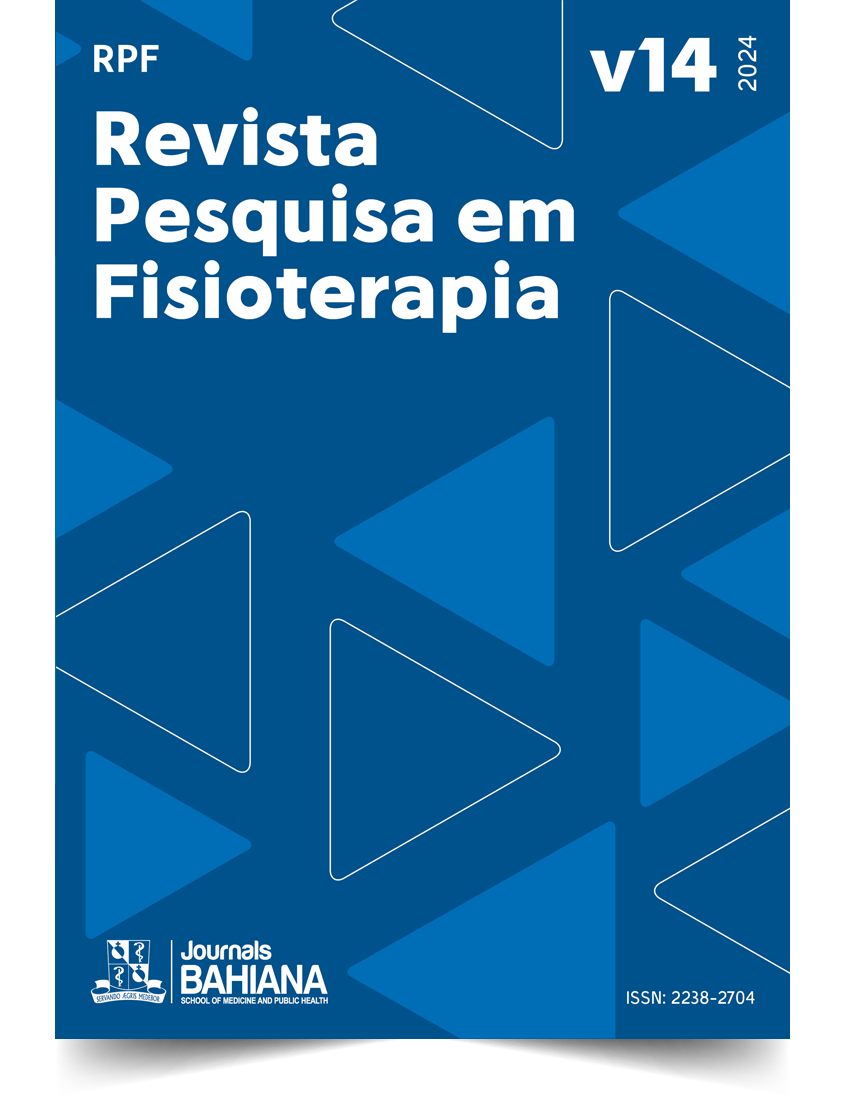Influência do uso do diário de caminhada na mobilidade de pacientes em reabilitação cardíaca fase 1: ensaio clínico randomizado
DOI:
https://doi.org/10.17267/2238-2704rpf.2024.e5664Palavras-chave:
Reabilitação Cardíaca, Caminhada, MobilizaçãoResumo
INTRODUÇÃO: A reabilitação hospitalar é extremamente importante para pacientes em recuperação de cirurgia cardíaca. Embora o diário de caminhada seja rotineiramente utilizado na prática clínica, ele ainda não foi adequadamente testado e relatado na literatura. OBJETIVOS: Estabelecer se o uso do diário de caminhada afeta o número de passos dados após cirurgia cardíaca e se isso está relacionado ao nível de ansiedade cardíaca do paciente. MÉTODOS: Foi realizado um ensaio clínico aberto, controlado e randomizado com pacientes adultos submetidos à cirurgia eletiva de valva e/ou coronária, sem comprometimento motor. Todos os participantes usaram um pedômetro para registrar o número de passos dados ao longo de cinco dias consecutivos de internação. Vinte e nove indivíduos foram randomizados para um grupo de intervenção para usar o diário de caminhada como estratégia de tratamento, enquanto vinte e três foram alocados para um grupo controle. O teste de Mann-Whitney foi utilizado para comparar o número de passos entre os dois grupos, enquanto o coeficiente de correlação de Spearman foi realizado para avaliar a relação entre o número de passos e o nível de ansiedade cardíaca. A significância estatística foi definida como p < 0,05. RESULTADOS: Os grupos foram semelhantes quanto às características demográficas, clínicas e cirúrgicas. Não houve diferença entre os grupos quanto ao número total de passos dados: grupo controle=1.496 (477,5 - 2.992,5) vs. grupo intervenção=1.468,5 (494,2 - 2.678) (p=0,902). CONCLUSÃO: O uso do diário de caminhada não teve efeito no número de passos dados e não foi associado ao nível de ansiedade cardíaca em pacientes internados após cirurgia cardíaca.
Downloads
Referências
(1) Jessup RL, Buchbinder R. What if I cannot choose wisely? Addressing suboptimal health literacy in our patients to reduce over-diagnosis and overtreatment. Intern Med J. 2018;48(9):1154–7. https://doi.org/10.1111/imj.14025
(2) Cordeiro ALL, Queiroz GO, Souza MM, Guimarães AR, Araújo TM, Correia Junior MAV, et al. Tempo de ventilação mecânica e força muscular periférica na pós-cirurgia cardíaca. Int J Cardiovasc Sci. 2016;29(2):134–8. Disponível em: https://pesquisa.bvsalud.org/portal/resource/pt/biblio-831104
(3) Morais DB, Lopes ACR, Sá VM, Silva Júnior WM, Cerqueira Neto ML. Evaluation of functional performance in patients undergoing cardiac surgery. Rev Bras Cardiol. 2010;23(5):263–9. Available from: https://pesquisa.bvsalud.org/portal/resource/pt/lil-568754
(4) Costa Junior JMF, Almeida KS, Santos MCS, Carneiro SR, Torres DC. Pedometer evaluation in patients in post-operative surgery coronary artery bypass grafting after early mobilization in bed intensive care unit. Rev Para Med. 2015;29(2):45–50. http://dx.doi.org/10.13140/RG.2.2.31924.71045
(5) Papaspyros S, Uppal S, Khan SA, Paul S, O’Regan DJ. Analysis of bedside entertainment services’ effect on post cardiac surgery physical activity: a prospective, randomised clinical trial. Eur J Cardiothoracic Surg. 2008;34(5):1022–6. https://doi.org/10.1016/j.ejcts.2008.05.042
(6) Mungovan S, Singh P, Gass G, Smart N, Hirschhorn A. Effect of physical activity in the first five days after cardiac surgery. J Rehabil Med. 2017;49(1):71–7. https://doi.org/10.2340/16501977-2165
(7) Takahashi T, Kumamaru M, Jenkins S, Saitoh M, Morisawa T, Matsuda H. In-patient step count predicts re-hospitalization after cardiac surgery. J Cardiol. 2015;66(4):286–91. https://doi.org/10.1016/j.jjcc.2015.01.006
(8) Heizmann AN, Chapelle C, Laporte S, Roche F, Hupin D, Le Hello C. Impact of wearable device-based interventions with feedback for increasing daily walking activity and physical capacities in cardiovascular patients: a systematic review and meta-analysis of randomised controlled trials. BMJ Open. 2023;13(7):e069966. https://doi.org/10.1136%2Fbmjopen-2022-069966
(9) Lee PH, Macfarlane DJ, Lam T, Stewart SM. Validity of the international physical activity questionnaire short form (IPAQ-SF): A systematic review. Int J Behav Nutr Phys Act. 2011;8(115):1-11. https://doi.org/10.1186/1479-5868-8-115
(10) Sardinha A, Nardi AE, Araújo CGS, Ferreira MC, Eifert GH. Brazilian Portuguese Validated Version of the Cardiac Anxiety Questionnaire. Arq Bras Cardiol. 2013;101(6):554-61. https://doi.org/10.5935/abc.20130207
(11) Lordello GGG, Gama GGG, Rosier GL, Viana PADC, Correia LC, Ritt LEF. Effects of cycle ergometer use in early mobilization following cardiac surgery: a randomized controlled trial. Clinical Rehabilitation. 2020;34(4):450–459. https://doi.org/10.1177/0269215520901763
(12) Rosier GL, Lordello GGG, Moura MA, Correia LS, Polte LLS, Gardenghi G, et al. Mobility after Heart Surgery: What Are Influential Factors? J Pharm Pharmacol. 2018;6(4):429-35. http://dx.doi.org/10.17265/2328-2150/2018.04.016
(13) Izawa KP, Watanabe S, Hiraki K, Morio Y, Kasahara Y, Takeichi N, et al. Determination of the effectiveness of accelerometer use in the promotion of physical activity in cardiac patients: A randomized controlled trial. Arch Phys Med Rehabil. 2012;93(11):1896–902. https://doi.org/10.1016/j.apmr.2012.06.015
(14) Hirschhorn AD, Richards D, Mungovan SF, Morris NR, Adams L. Supervised Moderate Intensity Exercise Improves Distance Walked at Hospital Discharge Following Coronary Artery Bypass Graft Surgery-A Randomised Controlled Trial. Heart Lung Circ. 2008;17(2):129–38. https://doi.org/10.1016/j.hlc.2007.09.004
(15) Sallis R, Roddy-Sturm Y, Chijioke E, Litman K, Kanter MH, Huang BZ, et al. Stepping toward discharge: Level of ambulation in hospitalized patients. J Hosp Med. 2015;10(6):384–9. https://doi.org/10.1002/jhm.2343
(16) Eser P, Gonzalez-Jaramillo N, Weber S, Fritsche J, Femiano R, Werner C, et al. Objectively measured adherence to physical activity among patients with coronary artery disease: Comparison of the 2010 and 2020 World Health Organization guidelines and daily steps. Front Cardiovasc Med. 2022;28(9):951042. https://doi.org/10.3389%2Ffcvm.2022.951042
(17) Vasavi VL, Khandekar J, Singh VP, Samuel SR, D’Souza MC. Effectiveness of pedometer-based exercise program in phase 1 and phase 2 cardiac rehabilitation: A Systematic Review [version 1; peer review: 2 not approved]. F1000Research. 2022;11:451 https://doi.org/10.12688/f1000research.109941.1
(18) Whyte J, Dijkers MP, Hart T, Van Stan JH, Packel A, Turkstra LS, et al. The Importance of Voluntary Behavior in Rehabilitation Treatment and Outcomes. Arch Phys Med Rehabil. 2018;100(1):156-63. https://doi.org/10.1016/j.apmr.2018.09.111
(19) Hart T, Dijkers MP, Whyte J, Turkstra LS, Zanca JM, Packel A, et al. A Theory-Driven System for the Specification of Rehabilitation Treatments. Arch Phys Med Rehabil. 2019;100(1):172–80. https://doi.org/10.1016/j.apmr.2018.09.109
Downloads
Publicado
Edição
Seção
Licença
Copyright (c) 2024 Gabriela Lago Rosier, Gleide Glícia Gama Lordello, Patrícia Alcântara Doval de Carvalho Viana, Luiz Eduardo Fonteles Ritt, Gilson Soares Feitosa Filho

Este trabalho está licenciado sob uma licença Creative Commons Attribution 4.0 International License.
Esta obra está licenciada com uma Licença Creative Commons Atribuição 4.0 Internacional.



